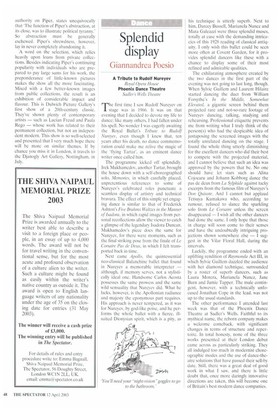Splendid display
Giannandrea Poesio
A Tribute to Rudolf Nureyev Royal Opera House Phoenix Dance Theatre Sadler 's Wells Theatre
The first time I saw Rudolf Nureyev on stage was in 1966. It was on that evening that I decided to devote my life to dance; like many others, I had fallen under his spell. No wonder [was eagerly awaiting the Royal Ballet's Tribute to Rudolf Nureyev, even though I knew that, ten years after his death, no dance commemoration could make me relive the magic of the 'flying Tartar', as an eminent dance writer once called him.
The programme kicked off splendidly. Irek Mukhamedov, another Tartar, brought the house down with a self-choreographed solo, Memories, in which carefully placed, unpretentious references to some of Nureyev's celebrated roles punctuate a seamless display of artistry and technical bravura. The effect of this simple yet engaging dance is similar to that of Frederick Ashton's Five Brahms Waltzes in the Manner of Isadora, in which rapid images from personal recollections allow the viewer to catch a glimpse of the legendary Isadora Duncan. Mukhamedov's piece does the same for Nureyev, for there were moments, such as the final striking pose from the finale of Le Corsaire Pas de Deux, in which I felt transported back in time.
Next came Apollo, the quintessential neo-classical Balanchine ballet that found in Nureyev a memorable interpreter — although, if memory serves, not a stylistically ideal one. Handsome Carlos Acosta possesses the same prowess and the same wild sensuality that Nureyev did. What he lacks, however, is the Apollonian radiance and majesty the eponymous part requires. His approach is never tempered, as it was for Nureyev, by god-like poise, and he performs the whole ballet with a fierce. illsuited Dionysian spirit, which is a pity, as his technique is utterly superb. Next to him, Darcey Bussell, Marianela Nunez and Mara Galeazzi were three splendid muses, totally at ease with the demanding intricacies of this 1928 reading of classical antiquity. I only wish this ballet could be seen more often at Covent Garden, for it provides splendid dancers like these with a chance to display some of their most refined and admirable qualities.
The exhilarating atmosphere created by the two dances in the first part of the evening was not going to last long, though. When Sylvie Guillem and Laurent Hilaire started dancing the duet from William Forsyt he's In the Middle, Somewhat Elevated, a gigantic screen behind them projected rare and not-so-rare footage of Nureyev dancing, talking, studying and rehearsing. Professional etiquette prevents me from writing what I truly think of the person(s) who had the despicable idea of juxtaposing the screened images with the totally unrelated dancing on the stage. I found the whole thing utterly diminishing for the excellent dancers who did their best to compete with the projected material, and I cannot believe that such an idea was approved by the powers that be. No one should have let stars such as Alina Cojocaru and Johann Kobborg dance the pas de deux from La Sylphide against tacky excerpts from the famous film of Nureyev's Don Quixote. And I cannot but applaud Tetsuya Kumakawa who, according to rumour, refused to dance the sparkling solo from Le Corsaire unless the screen disappeared — I wish all the other dancers had done the same. I only hope that those in charge will soon come to their senses and have the undoubtedly intriguing projections shown somewhere else — I suggest in the Vilar Floral Hall, during the intervals.
Luckily, the programme ended with an uplifting rendition of Raymonda Act III, in which Sylvie Guillem dazzled the audience with her diamond technique, surrounded by a roster of superb dancers, such as Laura Morera, Marianela Nunez, Jane Burn and Jamie Tapper. The male contingent, however, with a technically unfocused Jonathan Cope in the lead, was not up to the usual standards.
The other performance I attended last week was that of the Phoenix Dance Theatre at Sadler's Wells. Faithful to its mythical name, the reborn company makes a welcome comeback, with significant changes in terms of structure and repertoire. In total honesty, none of the three works presented at their London debut came across as particularly striking. They all indulged too much in modernist choreographic modes and the use of dance-theatre solutions that have passed their sell-by date. Still, there was a great deal of good work in what I saw, and there is little doubt that, once more daringly innovative directions are taken, this will become one of Britain's best modern dance companies.


































































 Previous page
Previous page